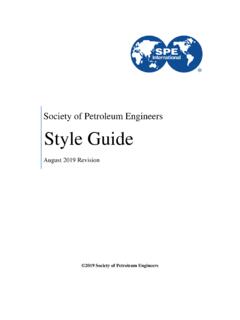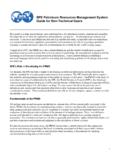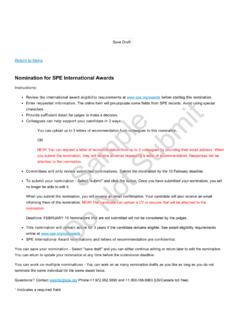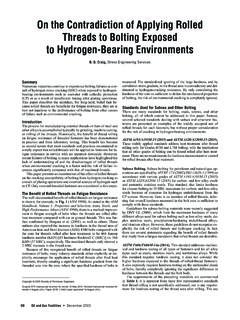Transcription of Unit Conversion Factors
1 unit Conversion Factors The Conversion Factors shown below are approximate and were taken from a variety of sources. When dealing with liquid or gaseous hydrocarbons, the actual volume, weight, mass, or heat content may depend upon a range of Factors such as the specific gravity of the fluid, the amount (if any) of water entrained in the mixture, the temperature and pressure at which the measurements are taken, and other Factors . Consequently, in many cases there is no single factor that can be used for Conversion . The Factors below may be used as rules of thumb and will work for general comparison purposes or calculations.
2 Thermal Conversion Factors measure the equivalent heating content of various fuels in British Thermal Units (Btus). In the , common practice is to use the gross or upper end of the range of heat content values for a specific product. In Europe, net or lower end heat content rates are typically used. The difference is the amount of energy that is consumed to vaporize the water created during the combustion process. This difference is typically 2 to 10%, depending on the specific fuel and its hydrogen content. Some fuels, such as unseasoned wood, can be more than 40% different in their gross and net heat content rates.
3 [Source: Department of Energy, Energy Information Administration] Conversion tables included: Volume Mass/Weight Length Area Energy Approximate Heat Content of Petroleum Products Million Btu (MMBtu) per Barrel Volume unit multiplied by Approximate Conversion Factor equals unit barrels of oil (bbl) X 42 = US gallons (gal) barrels of oil (bbl) X = Imperial gallons (UK gal) barrels of oil (bbl) X = tonnes of oil equivalent (toe) barrels of oil (bbl) X = cubic metres (m3) barrels of oil equivalent (boe) X 5, = cubic feet (f3) of natural gas tonnes of oil equivalent (toe) X [1] = barrels of oil equivalent (boe) cubic yards (y3) X = cubic metres (m3) cubic feet (f3)
4 X = cubic metres (m3) cubic feet (f3) of natural gas X = barrels of oil equivalent (boe) US gallons (gal) X = barrels (bbl) US gallons (gal) X = liters (l) US gallons (gal) X = Imperial gallons (UK gal) Imperial gallons (UK gal) X = US gallon (gal) Imperial gallons (UK gal) X = liters (l) [1] This Conversion can range from to depending on the type of crude oil. This factor is intended to provide an approximation that can be used when the exact factor is unknown. Mass/Weight unit multiplied by Approximate Conversion Factor equals unit short tons X 2,000 = pounds (lb) short tons X = metric tonnes (t) long tons X = metric tonnes (t) long tons X 2,240 = pounds (lb) metric tonnes (t) X 1,000 = kilograms (kg) metric tonnes (t) X = long tons metric tonnes (t) X = short tons pounds (lb) X = kilograms (kg) kilograms (kg) X = pounds (lb) Length unit multiplied by Approximate Conversion Factor equals unit miles (mi) X = kilometers (km) yards (yd) X = meters (m) feet (ft) X = meters (m) inches (in) X = centimeters (cm) kilometer (km)
5 X = miles (mi) Area unit multiplied by Approximate Conversion Factor equals unit acres X = hectares (ha) square miles (mi2) X = square kilometers (km2) square yards (yd2) X = square meters (m2) square feet (ft2) X = square meters (m2) square inches (in2) X = square centimeters (cm2) Energy unit multiplied by Approximate Conversion Factor equals unit British Thermal Units (Btus) X 1, = joules (J) calories (cal) X = joules (J) kilowatt hours (kWh) X = megajoules (MJ) therms X 100,000 = British thermal units (Btus) tonnes of oil equivalent X 10,000,000 = kilocalories (kcal) tonnes of oil equivalent X = therms tonnes of oil equivalent X = gigajoules (GJ) tonnes of oil equivalent X 11,630 = kilowatt hours (kWh) cubic feet (f3) of natural gas X 1,025 = British Thermal Units (Btus) Approximate Heat Content of Petroleum Products Million Btu (MMBtu) per Barrel Energy Source MMBtu/bbl Energy Source MMBtu/bbl Crude Oil Natural Gasoline Natural Gas Plant Liquids Pentanes Plus Asphalt Petrochemical Feedstocks.
6 Aviation Gasoline Naphtha < 401 F Butane Other oils >= 401 F Butane-Propane (60/40) Mixture Still Gas Distillate Fuel Oil Petroleum Coke Ethane Plant Condensate Ethane-Propane (70/30) Mixture Propane Isobutane Residual Fuel Oil Jet Fuel, Kerosene-type Road Oil Jet Fuel, Naphtha-type Special Naphthas Kerosene Still Gas Lubricants Unfinshed Oils Motor Gasoline - Conventional Unfractionated Stream Motor Gasoline - Oxygenated or Reformulated Waxes Motor Gasoline - Fuel Ethanol Miscellaneous Source: Department of Energy, Energy Information Administration (2001)











